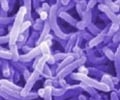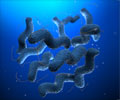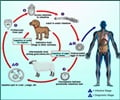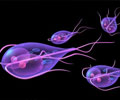Cryptosporidium lurks worldwide in water, contaminating swimming pools, water parks, and drinking water supplies and has been the scrouge of mankind ever since it was discovered in 1976
Cryptosporidium lurks worldwide in water, contaminating swimming pools, water parks, and drinking water supplies and has been the scrouge of mankind ever since it was discovered in 1976
Although it has even been featured on the comedy show The Colbert Report, it is no laughing matter—this microscopic pathogen is a leading cause of diarrhea and malnutrition and the most common source of infection in immune-weakened people such as AIDS patients. It is also a potential bioterrorism agent."All you need is a cow and a centrifuge to harvest enough oocysts to infect a small city," says Brandeis University biochemist Liz Hedstrom. Roughly 20 percent of calves are infected by cryptosporidium oocysts, which are found in their feces. In 1993, in the largest waterborne disease outbreak in U.S. history, this nasty protozoan parasite infiltrated Milwaukee's municipal water supply, killing more than 100 people and sickening some 400,000.
Cryptosporidium invades the small intestine, where it opens fire, typically causing severe gastrointestinal distress and even death in people with weakened immune systems. Cryptosporidium is a hardy foe whose oocysts—a spore-like phase in the parasite life cycle—remain stable outside a host for long periods and are resistant to conventional water treatment such as chlorine disinfection.
The latest research news on this waterborne foe will be the focus of Hedstrom's talk, titled "Targeting a prokaryotic protein in a eukaryotic parasite," at the American Society for Biochemistry and Molecular Biology's annual meeting. The talk will be held in the Anaheim Convention Center, Room 304C, on Sunday April 25 at 9:55 am PST. Hedstrom's promising research could lead to an effective treatment to prevent cryptosporidiosis.
Hedstrom and her collaborators made a critical breakthrough in eroding cryptosporidium defenses when they identified IMPDH, a key enzyme involved in the biosynthesis of RNA and DNA, as a potential drug target. Her research has shown that IMPDH inhibitors block the parasite from proliferating in vitro. Importantly, the Cryptosporidium IMPDH has very different properties from those of the human enzyme counterpart.
Next, Hedstrom and her colleagues identified compounds that blocked the action of the Cryptosporidium IMPDH, but spared human IMPDH. Leading a large-scale screen of a commercial library containing 129,000 compounds, Hedstrom discovered more than fifty compounds that specifically inhibit the parasite enzyme. A number of these compounds display antiparasitic activity. Hedstrom is now working on improving the compounds' potency, bioavailability and metabolic stability, a first step in the drug development process.
Advertisement
Advertisement
RAS












